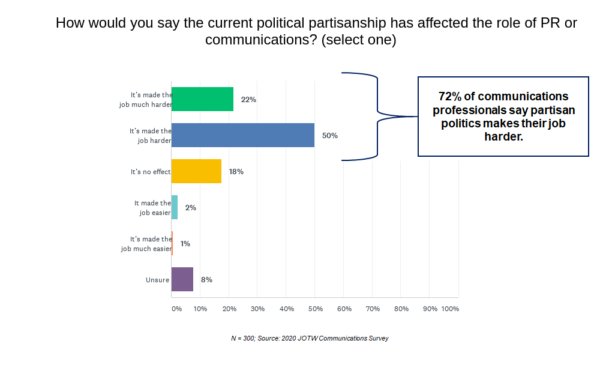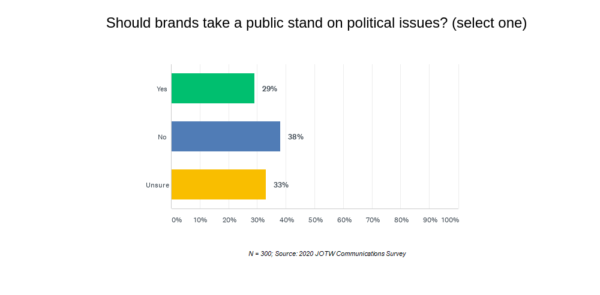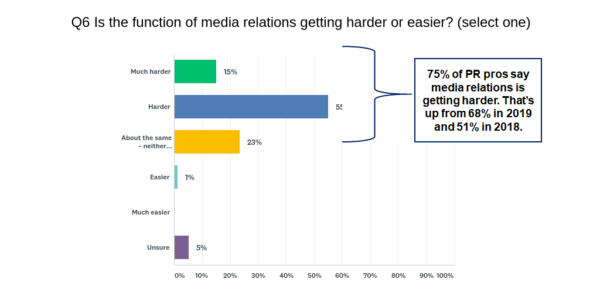Nearly three-quarters of professional communicators say partisan politics has complicated communications for brands and businesses.
That’s according to the 2020 JOTW Communications Survey which polled 300 communicators – public relations, public affairs, marketing communications and related roles – across more than a dozen different industries.
Specifically, some 72% of professionals believe the political landscape has made their jobs harder. When asked why, in an open-ended follow-up question, many suggested the state of politics today means the things brands and businesses communicate today are viewed through a political lens – even if there is no intent to be political.
“It’s sucking up all the oxygen,” according to one respondent. Here are some of the other verbatim comments:
- “EVERYTHING is now seen through a political filter. Issues that should not be political now are.” (Answered: made the job much harder).
- “The divisiveness bleeds through and is reflected in areas beyond politics.” (Answered: made the job harder).
- “Some people have leave to say anything now. We’ve unmoored media from accuracy.” (Answered: made the job easier).
It’s important to note that the survey Coronavirus pandemic was taking off just as this survey was wrapping up. Indeed, the day the survey closed; the WHO declared the virus a pandemic. However, there’s been no observable slowing in political partisanship, in fact, it’s arguably accelerated as we head toward election day in November.
Should Brands Take a Stand on Politics?
Although businesses and brands may find themselves thrust into a political spectrum, there is little agreement among communications professionals on whether or not brands should embrace the role.
While more respondents (38%) said “no” brands should not take a stand – and that represents the single largest grouping of answers – it’s not a majority. In fact, respondents are split almost evenly in three-ways with 29% saying “yes” they, should and 33% saying they are “unsure.”
Importantly, many respondents indicated they were are open to changing their minds depending on the issue, context and business.
Here is what a few respondents said in their own words:
- “Brands should take a public stand on issues when there is a clear connection with the brand’s values.” (Answered: yes, brands should take a stand)
- “Because you automatically alienate 50% of the general public.” (Answered: no, brands should not take a stand)
- “Totally depends on the client the issue and how the issue is in play. That is, yes. But, no.” (Answered: unsure, brands should take a stand)
Interestingly, the results closely mirror a 2018 survey that asked consumers if they wanted brands to take a stand on politics.
Top Challenges, Media Relations, Tactics, Social Media and Measurement
Every year the survey asks respondents a wide range of questions related broadly to communications. Below are a few more of the topline findings.
1. The top comms challenges have changed.
Budget was replaced as the top challenge facing communicators with proving value and ROI. The second top challenge seems related – an “executive team that doesn’t understand comms.” The in-housing trend appears to have slowed; just 30% of respondents say they’ve observed more work going in-house compared with 47% in 2019.
2. Media relations gets harder.
Seventy-five percent of PR pros say media relations is getting harder. That’s up from 68% in 2019 and 51% in 2018. In terms of approach, 64% say exclusives are useful; and 61% still find value in press releases; 52% say embargoes can help. Sentiment around these questions suggests judicious use is well-advised.
3. Top tactics in PR and comms.
The top five communications tactics based on a weighted average are:
- data and analytics;
- storytelling;
- content marketing, blogging, and brand journalism;
- business social responsibility; and
- thought leadership.
One respondent defined storytelling aptly as “Developing a narrative arc with strong, relatable characters who live their values and make a difference.”
4. Social media platforms.
LinkedIn, YouTube and Instagram all ranked in the top three social networks by weighted average. Twitter ranked fourth even though other surveys show it remains a popular platform among journalists and reporters.
5. PR measurement.
In terms of communications and PR measurement, almost half of respondents (48%) measure “often” or “always”; the other half measure their efforts just “sometimes,” (38%) “rarely,” (11%) or “never” (2%). The contrast of this finding with the findings that “proving value” to an executive team that doesn’t understand comms are the top two challenges is striking.
About the JOTW Communications Survey
Ned’s Job of the Week (JOTW) newsletter and Sword and the Script Media conducted the third annual JOTW Communications Survey to understand trends in the field of communications.
A total of 300 professionals took the survey:
- 95% of respondents are based in the U.S.;
- 92% report having 11 or more years of experience;
- 52% of respondents are in-house communicators; and
- respondents come from more than a dozen different industries.
Detailed demographics are included at the end of the full report, which is freely available for download on SlideShare.
A version of this post was first published on Sword and the Script.
Image credit: Photo by Alejandro Barba on Unsplash


